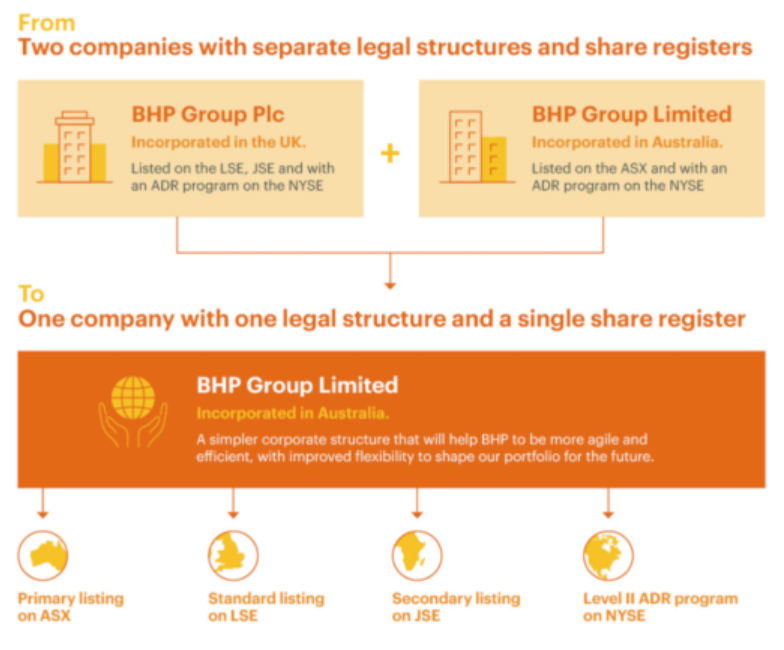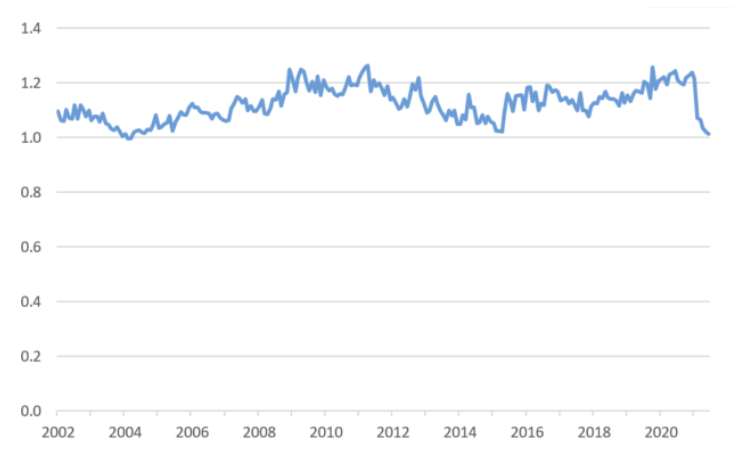The Big Australian comes home
Incorporated in 1885, BHP Group (ASX: BHP) began as a silver, lead and zinc mine in Broken Hill, Australia.
Over the next century, the company grew into one of the largest diversified resource companies in the world with operations including oil and gas, steel production and mining of a variety of commodities including copper, potash, coal and diamonds. It was listed on the Australian stock exchange in July 1961, making it the oldest company currently trading, and throughout much of this time, it has been the largest company on the ASX by market capitalisation (currently it is ranked third).
In 2001 BHP announced it would merge with fellow resource powerhouse Billiton. Billiton also had a long history dating back to a single tin mine in 1851 before growing into a major producer of aluminium, alumina, chrome, manganese, steaming coal, nickel and titanium. The company was Dutch controlled from inception before being acquired by South African firm Gencor in 1994.
As the world’s largest metals and mining corporation, BHP Billiton began trading in July 2002 and operates as a dual-listed company (DLC) – a corporate structure in which two companies have merged into a single operating business but retain separate legal identities and stock exchange listings (in this case Australia and the United Kingdom(1)).
The DLC was the most effective way at the time to execute the merger of two very large companies in different jurisdictions. But over the years it has frequently drawn confusion and criticism particularly as the business changed. Most notably in 2017 some institutional shareholders, led by US-based Elliot Corporation (which held 5% of the company) began strongly advocating collapsing the DLC.
In August 2021 the company announced its intention to ‘unify’ or collapse the dual listing, consolidating into one company, BHP Group Limited, incorporated in Australia. This will see BHP Group PLC delist from the London Stock Exchange (LSE) in the UK and the shares transferred to the Australian ASX listing of BHP Group Limited.
This has impacts on both the composition of benchmark indices and the Realindex funds.
The changes proposed by the company
The picture below illustrates the proposed changes. Note that BHP will still trade in the UK but it will be a ‘cross listing’ of the Australian shares as is currently available via South Africa and the US.
BHP unification explained

Source: BHP Company Website, December 2021.
Key dates as released by the company and benchmark index providers are detailed below.
BHP unification timeline

Source: BHP Company Website, UBS, December 2021.
The benefits of ending the dual listing include:
1. Simplicity
Currently, BHP has to adhere to both Australian and UK corporation laws and as such must duplicate a lot of functions e.g. produce 2 separate annual reports (and 1 consolidated), have 2 boards and hold 2 separate annual general meetings. Unification will result in these functions only being required once.
2. Flexibility
Dual listings make it difficult to use shares as consideration in mergers, in fact, BHP has used cash in all its mergers and acquisition (M&A) activity since 2002 whereas scrip funding globally is over 40% for other Resource companies and 38% in the broader market(2).
For example, BHP has announced it will merge its petroleum business with Woodside Petroleum after unification to make it easier to complete as Woodside scrip will be issued to BHP shareholders.
3. Benefits of the DLC have been removed
In 2017 BHP resisted collapsing the DLC by claiming it would cost around US$1.7b. The company now claims costs will be around US$400m. The reduction is largely due to the removal of Australian corporate tax benefits that the company was receiving through the DLC structure (that allowed the paying of some tax in lower offshore jurisdictions).
4. Better use of Franking Credits
At the time of merging both companies contributed similar amounts to earnings. Since then due to asset sales, changes in commodity prices and the South32 demerger the UK assets now only produce 5% of the companies’ earnings. However, under the DLC shares in both companies have equivalent economic interests in BHP Group. As a result since 2016 BHP Ltd. has had to pay fully franked dividends to BHP PLC. As BHP PLC is a UK company, it cannot distribute Australian franking credits.
For example in FY21 BHP Ltd paid US$3.525 billion in dividends with US$1.504 billion in franking credits to BHP Plc, with these franking credits expiring within the DLC structure as they could not be passed onto non-Australian shareholders(3).
As upon unification, all BHP shares will be BHP Ltd shares and hence all dividends will be fully franked.
5. End of the difference in share prices between Australia and London
After merging in 2001 the 2 companies maintained two separate non-fungible listings which, after adjusting for currency, should have traded in line with each other given each company had the same economic and voting rights. However, except for a brief few months of parity in 2004, the Australian line has always traded at a premium to the UK line. Even more confusing is that the amount of this premium has varied significantly over time (as much as 25% in 2011) as can be seen in the following chart.
BHP listings (Australian listing / London listing)

Source: Factset. Data as of 31 December 2021.
Reasons for the pricing differences have never been clearly agreed upon but include the following reasons:
- The presence of franking credits in Australia
- Larger relative inflows into the ASX due to compulsory superannuation in Australia and a stronger Australian economy
- BHP has a much larger weighting in the Australian equity market than the UK as shown the table below. This results in more buying by both passive funds and by active managers.

This share price differential has attracted more than its fair share of hedge fund activity with traders attempting to profit from change in the levels of the spread between the two listings, resulting in increased price volatility.
The chart above also shows this spread has continued to close since the August announcement but a different trade is now in play. Since the announcement traders have heavily shorted the ASX-listed BHP shares and purchased up the cheaper PLC shares (which will convert to the ASX line on January 31st if the vote is successful). As the chart below shows short interest in BHP is currently at all-time highs (since data was available in 2010).
BHP short interest (Australian listing)

Source: Factset, ASX, Data as at 31st December 2021.
Dual-listed structures fall out of favour
At their peak in the 2000s, there were up to 15 dual-listed companies but only five (including BHP) currently remain as listed below.
Current dual-listed companies

Source: Factset. Data as at 31st December 2021.
Previous DLCs are listed below. A common reason many have given for ending is that M&A such as scrip based acquisitions and demergers are more difficult to execute. For example, as highlighted with BHP above DLC companies have used cash in 99.5% of their transactions(4).
Previously dual-listed companies

Source: Factset. Data as at 30th June 2021.
Impact on benchmark indices
Unification will result in a single Australian company with this listing only eligible for inclusion in the Australian benchmark indices (as index inclusion is based on country of domicile). As shown in the timeline earlier, if approved, MSCI and FTSE will delete BHP Group PLC and "upweight" BHP Group Limited in the respective indices at the market close on 28 January.
S&P will announce on 14th January whether they will make these changes in one or two tranches due to the large size of the upweight in the S&P/ASX200 and the amount of money benchmarked against this (and the S&P/ASX300) indices. As the table shows below (data from December 31st) BHP’s weight in the S&P/ASX200 will increase by 3.7% (from 5.8% to 9.5%) and it become the largest company in the benchmark. S&P estimate buying of BHP of $10.8 billion or around 34 days volume(5) as in addition to required buying by passive funds many active managers will need to purchase the stock in order to maintain the size of their active positions.
If completed in one tranche it will also be done at close 28th January. Should S&P decide to split the changes over 2 tranches it is expected that a 50% upweight will occur on 28th January with the remaining upweight included with the quarterly March rebalance.
S&P/ASX200 – largest stock changes due to BHP upweight

Source: Realindex, S&P. Data as at 30th December 2021.
At a sector level Materials will increase by over 3% with the dominant Financials sector proportionally downweighted.
S&P/ASX200 – sector changes due to BHP upweight

Source: Realindex, Macquarie Research. Data as at 31st December 2021.
Will Rio Tinto be next?
Similar to BHP, Rio Tinto is also an Anglo-Australian multi-national resource company. It was formed as a dual-listed entity in 1995 through the merger of Rio Tinto Zinc (a UK company) and the smaller Australian firm CRA Limited. The ratio of the listing has changed since 1995 due to shares buybacks in Australia reducing the shares on issue on the ASX as shown below.
Sector changes post BHP unification – Australian share fund

Source: Realindex, Factset. Data as at 30th December 2021.
Despite pressure on dual-listed companies to simplify, we would not expect Rio Tinto to unwind its DLC structure in the near term. This is because such an attempt would likely see it shift its primary listing to the UK, where 77% of the entity is listed (and hence a larger proportion of its shareholders). But a large portion of its profits come from Australia (due largely to record Iron Ore prices in recent years) and hence the majority of corporate tax is paid in this country. As such a move would likely see major pushback from both the Australian government and local shareholders.
The most recent comments from Rio Tinto management indicate they have no plans in the near term to follow in the footsteps of BHP.
Conclusion
When BHP and Billiton merged in 2001 the creation of the dual listing company was a creative and effective arrangement. However the changing nature of BHP since 2001 means this structure is now highly inefficient and costly (particularly in relation to Australian credits) whilst offering few advantages. Unification will provide a simpler corporate structure that will make BHP simpler and more agile for the future.
References
The move of the primary listing of Billiton from South Africa to the UK is consistent with the actions of other South African companies such as Anglo American and SAB. Reasons cited included better base for expansion and a greater access to capital markets.
Source: FTI consulting, 2017 based on M&A deals 1995-2017
Source: Ownership Matters, January 2022
Source: FTI consulting, 2017 based on M&A deals 1995-2017
Source: S&P consultation paper, November 2021.
Never miss an insight
Enjoy this wire? Hit the ‘like’ button to let us know. Stay up to date with my content by hitting the ‘follow’ button below and you’ll be notified every time I post a wire.
Not already a Livewire member? Sign up today to get free access to investment ideas and strategies from Australia’s leading investors.
1 stock mentioned

